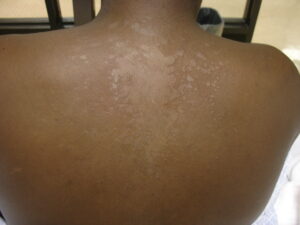
Tinea versicolor is one of the more common fungal infections that I see in my Conroe and The Woodlands dermatology clinics. Malassezia furfur and globes are the two most common types of yeast that cause tinea versicolor. This type of yeast grows in moist, humid climates and prefers oily/lipid-rich areas of the human body such as the neck, face, back, upper chest, and upper arms. Many patients acquire tinea versicolor at the gym from weight benches or other commonly shared equipment. Clinically, it appears as a rash that may have white or red/brown minimally scaly plaques. In many cases, tinea versicolor is self-diagnosed as vitiligo by the patient since it appears that the skin pigmentation has been lost. The yeast can temporarily halt melanosome transfer, so treated tinea versicolor will lack a scale but the discoloration remains until the melanosome transfer process begins to function properly. Diagnosis can be made with a scraping of skin treated with KOH that is then viewed under a microscope. Tinea versicolor has a characteristic “spaghetti and meatballs” appearance on microscopy, in which the yeast and hyphae appear like a pasta dish with the hyphae being the long spaghetti strands and the yeast being small round meatball like structures.
What Does Fungus Treatment for Tinea Versicolor Look Like?
My treatment regimen involves the antifungal, Nizoral (ketoconazole). I use 3 different forms of Nizoral: shampoo, cream, and pills. Nizoral 2% shampoo is prescribed to be used as a body wash, in which the patient lathers up their entire body and allows the shampoo to “sit” on the skin for 5-10 minutes prior to it being washed off. This allows time for the medicine to work and also provides topical coverage to the entire skin. I prescribe Nizoral 2% cream to be applied twice a day to the rash for one month. Finally, I prescribe an oral dose of Nizoral 400mg. It is to be taken with a soda or orange juice as it needs an acidic gastric level for it to be absorbed optimally. 2 hours after taking Nizoral 400mg, the patient should exercise until they develop a sweat. Once sweating occurs, exercising should cease and the sweat allowed to dry on the skin. The patient can watch TV for a few hours while the Nizoral is contained in the pores on the skin surface, so it can be interfacing with the yeast and exerting its antifungal mechanisms. This oral treatment is only done once at the beginning of the entire treatment regimen. Tinea versicolor can re-occur with future exposures, so patients are prescribed multiple refills on the shampoo and cream and can treat the fungus immediately if it arises again.
Learn more about how dermatologist Dr. Perri can help treat your fungus at our The Woodlands and Conroe offices.




